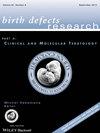Replication analysis of 15 susceptibility loci for nonsyndromic cleft lip with or without cleft palate in an italian population.
Q Medicine
Birth defects research. Part A, Clinical and molecular teratology
Pub Date : 2016-02-01
DOI:10.1002/bdra.23454
引用次数: 11
Abstract
BACKGROUND Nonsyndromic cleft lip with or without cleft palate (nsCL/P) is one of the most common congenital malformations in humans. Its average global incidence is 1.7 per 1000 live births, with wide variation according to geographical location and ethnicity. Its etiology involves both genetic and environmental factors. The aim of the present study was to confirm genetic association of a selection of 15 candidate nsCL/P loci using an independent sample of the Italian population. METHODS At least one single-nucleotide polymorphism (SNP) for each locus was genotyped in 380 nuclear trios. RESULTS Transmission disequilibrium analysis revealed significant associations for three variants at two loci (8q24 and 1p22). Two SNPs at 8q24 showed the strongest level of association, the rs987525 (PTDT = 6.81 × 10(-6) ; homozygous relative risk = 3.60 [95% confidence interval, 2.12-6.13]), and the rs17241253 (PTDT = 1.03 × 10(-5) ; homozygous relative risk = 3.75 [95% confidence interval, 2.10-6.67]). Four additional loci (at 1q32, 3q12, 8q21, and 10q25) achieved nominally significant p-values. Two SNPs at 1p36 achieved p-values of < 0.1. The present data suggest that 6 of the 15 analyzed nsCL/P risk loci contribute significantly to nsCL/P risk in the Italian population. These include the 1p22 locus, which previous research has implicated predominantly in Asian populations. CONCLUSION Different loci, including 8q24 and 1p22 have been found associated with nsCL/P in multiple populations. Further efforts are needed to identify causative variants and transfer knowledge to clinical application, such as personal genetic risk assessment.意大利人群非综合征性唇裂伴或不伴腭裂15个易感位点的复制分析。
背景:非综合征性唇裂伴或不伴腭裂(nsCL/P)是人类最常见的先天性畸形之一。其全球平均发病率为每1000例活产1.7例,因地理位置和种族而有很大差异。其病因包括遗传和环境因素。本研究的目的是利用意大利人群的独立样本,确认选择的15个候选nsCL/P位点的遗传关联。方法380例核三联体中每个位点至少有1个单核苷酸多态性(SNP)。结果基因传递不平衡分析显示,两个基因座(8q24和1p22)上的三个变异具有显著的相关性。8q24位点的2个snp相关性最强,rs987525位点(PTDT = 6.81 × 10(-6);纯合子相对危险度= 3.60[95%置信区间,2.12-6.13]),rs17241253 (PTDT = 1.03 × 10(-5);纯合子相对危险度= 3.75[95%可信区间,2.10-6.67])。另外四个位点(1q32、3q12、8q21和10q25)获得了名义上显著的p值。1p36处的两个snp的p值< 0.1。目前的数据表明,在分析的15个nsCL/P风险位点中,有6个对意大利人群的nsCL/P风险有显著贡献。其中包括1p22基因座,先前的研究表明它主要存在于亚洲人群中。结论在多个人群中发现了不同的位点,包括8q24和1p22与nsCL/P相关。需要进一步努力确定致病变异并将知识转移到临床应用,例如个人遗传风险评估。
本文章由计算机程序翻译,如有差异,请以英文原文为准。
求助全文
约1分钟内获得全文
求助全文
来源期刊

Birth defects research. Part A, Clinical and molecular teratology
医药科学, 胎儿发育与产前诊断, 生殖系统/围生医学/新生儿
CiteScore
1.86
自引率
0.00%
发文量
0
审稿时长
3 months
 求助内容:
求助内容: 应助结果提醒方式:
应助结果提醒方式:


